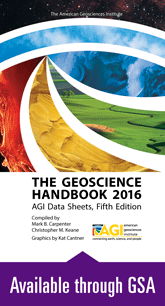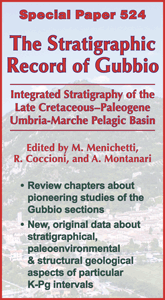Neogene-Quaternary intraforeland transpression along a Mesozoic platform-basin margin: The Gargano fault system, Adria, Italy
Abstract
We analyzed field structural data and an offshore seismic-reflection profile and compared them with previously published geological and geophysical data to constrain the tectonic evolution of the Gargano fault system, the kinematics of which have been the subject of contradictory interpretations. Field analyses show that the Gargano fault system consists of NW- to W-striking folds, thrusts, and left-lateral transpressional and strike-slip faults. A set of NW-striking solution cleavage supports the inference of an overall left-lateral kinematic regime for the Gargano fault system. Some synsedimentary structures indicate Miocene-Pliocene contractional and transpressional activity along the Gargano fault system, whereas strike-slip faults affecting Pleistocene conglomerates support a recent, left-lateral, strike-slip activity. The seismic-reflection data show that the offshore prolongation of the Gargano fault system consists of an anticline cut by high-angle faults arranged in a positive flower-like structure, which has mostly grown since middle-late Miocene times along a Mesozoic platform-basin margin. We have schematically reconstructed the tectonic evolution of the Gargano fault system between the middle-late Miocene and the present day. During this period, the Gargano fault system has mostly accommodated contractional to left-lateral transpressional and strike-slip displacements. These displacements are consistent with the regional, Neogene-Quaternary, contractional tectonics across Adria and the Apennines and Dinarides-Albanides fold-and-thrust belts. Some evidence suggests that the Gargano fault system is presently accommodating extensional or left-lateral transtensional displacements. We interpret the Neogene-Quaternary, strike-slip displacements on the Gargano fault system to be connected with the segmentation of the subducted Adriatic slab beneath the Apennines fold-and-thrust belt and with the noncylindrical evolution of this slab (i.e., differential retreating motions), which has undergone differential flexural movements in the adjacent, northern and southern Adriatic compartments.
Footnotes
-
↵GSA Data Repository item 2007060, Figure DR1 and Table DR1 (Figure DR1 contains the reprocessed F76–19 seismic-reflection profile across the southern Adriatic Sea, and Table DR1 contains the relative main acquisition and processing data), is available on the Web at http://www.geosociety.org/pubs/ft2007.htm. Requests may also be sent to editing@geosociety.org.
-
- Accepted 20 November 2006.
- Received 27 June 2006.
- Revision received 12 November 2006.
- The Geological Society of America, Inc.














